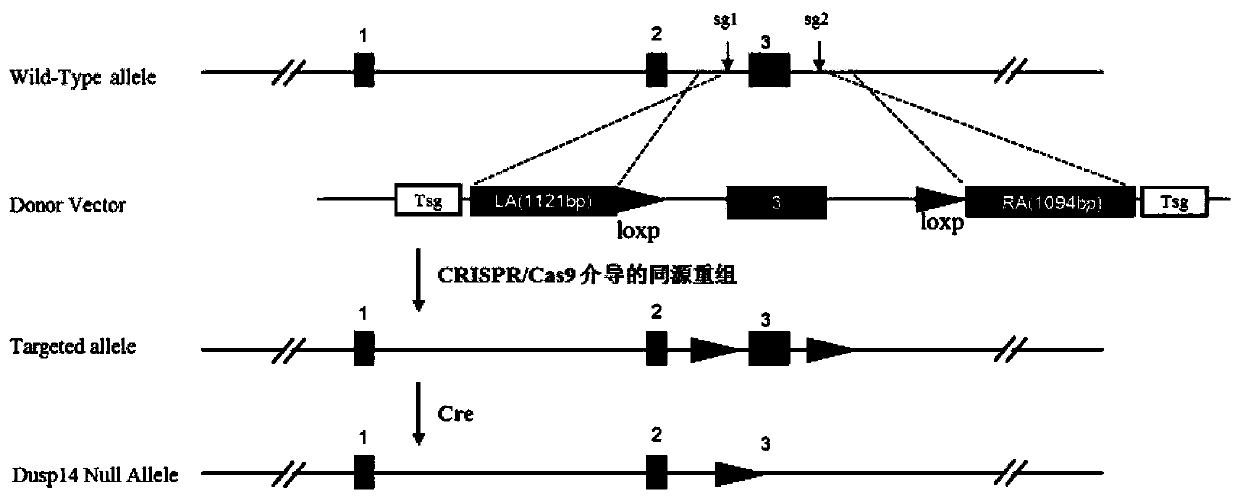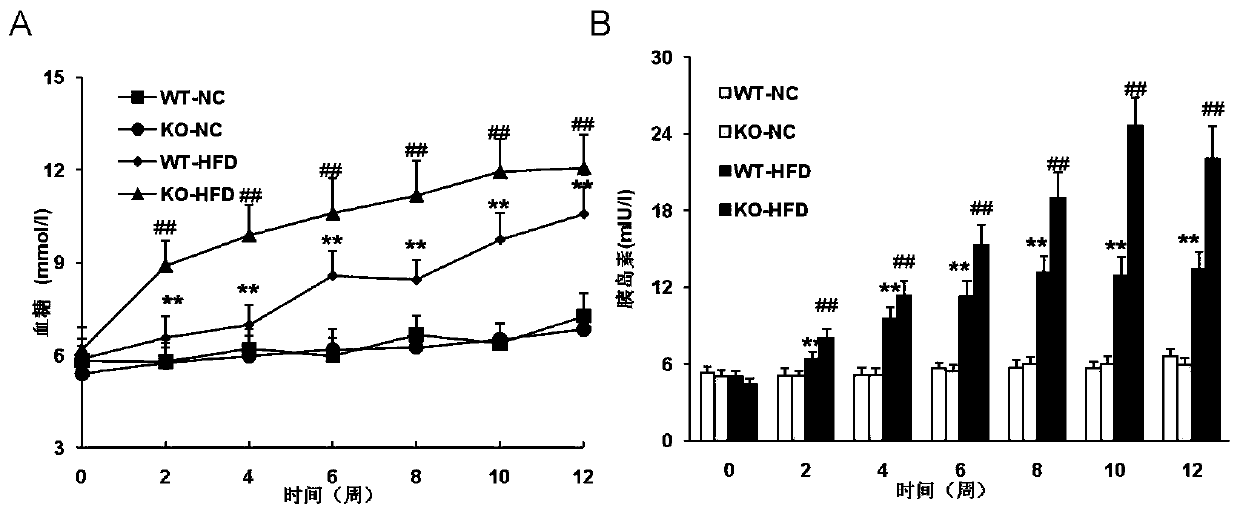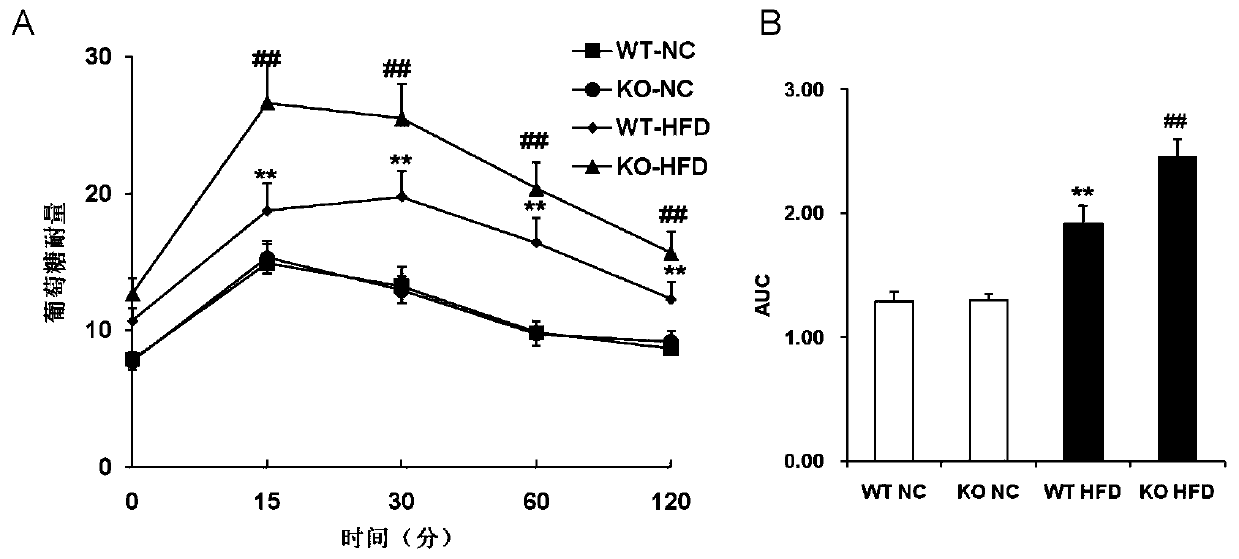Function and application of dual specificity phosphatase 14 in the treatment of non-alcoholic fatty liver disease and type Ⅱ diabetes
A fatty liver, right and wrong technology, used in gene therapy, metabolic diseases, pharmaceutical formulations, etc.
- Summary
- Abstract
- Description
- Claims
- Application Information
AI Technical Summary
Problems solved by technology
Method used
Image
Examples
Embodiment 1
[0057] [Example 1] Fatty liver in mice and type Ⅱ diabetes model (diet induced obesity, DIO) were obtained
[0058] (1) Grouping of experimental animals: 8-week-old, male, WT mice and DUSP14-KO mice were selected and given two special diets, D12942 high-fat diet (High fat diet, HFD) and D12450B low-fat diet (Normal chow , NC) feeding, that is, WT NC group, KO NC group, WT HFD group, KO HFD group, a total of 4 groups.
[0059] (2) The model induces the operation process through high-fat feed:
[0060] WT and KO mice were used to establish DIO models, and phenotype correlation analysis was performed to clarify the role of DUSP14 gene in fatty liver and type Ⅱ diabetes. 8-week-old, male, WT mice and DUSP14-DUSP14 mice were selected and fed with two special diets, D12942 high-fat diet (Highfat diet, HFD) and D12450B low-fat diet (Normal chow, NC), respectively, namely WT NC group, KO NC group, WT HFD group, KO HFD group, a total of 4 groups. The food intake of the mice was reco...
Embodiment 2
[0061] [Example 2] Determination of fasting blood glucose level and serum insulin level in mice
[0062] (1) Detection of fasting blood glucose level in mice
[0063] All the mice to be tested were fasted from 8:00 am to 2:00 pm (without water), that is, the experimental operation was started after 6 hours of fasting.
[0064]① Blood glucose meter preparation: Check the battery of the blood glucose meter (Johnson & Johnson, ONETOUCH, USA), press the switch on the right, put the test strip into the left slot correctly, the screen will display the number corresponding to the code of the blood glucose test strip, and then display the pattern of dripping blood, It prompts the blood glucose meter to enter the standby state.
[0065] ②Fix the mouse: hold the tail of the mouse in the right hand, hold a towel in the left hand, fold the towel in half, pinch the folded part of the towel with the thumb and forefinger, wrap the head and body of the mouse in the towel in the palm, place t...
Embodiment 3
[0088] [Example 3] Glucose tolerance test (intraperitoneal glucose tolerance test, IPGTT)
[0089] In the 12th week of the experiment, the intraperitoneal glucose injection test (IPGTT) was performed to evaluate the glucose tolerance of the mice.
[0090] (1) Before measuring blood glucose, measure the fasting body weight of the mice, and calculate the injection volume of glucose based on 10 μL / g.
[0091] (2) First detect the fasting blood glucose at 0 minutes before the glucose injection, and inject the glucose solution intraperitoneally quickly after the detection is completed.
[0092] (3) Operation method of intraperitoneal injection: ①Fix the mouse; grab the mouse, grab the tail of the mouse with the little finger and ring finger of the left hand, and grab the neck of the mouse with the other three fingers, so that the head of the mouse is downward, and the The abdomen of the mouse is fully exposed. ②Needle positioning and injection: insert the needle from the side of ...
PUM
 Login to View More
Login to View More Abstract
Description
Claims
Application Information
 Login to View More
Login to View More - R&D
- Intellectual Property
- Life Sciences
- Materials
- Tech Scout
- Unparalleled Data Quality
- Higher Quality Content
- 60% Fewer Hallucinations
Browse by: Latest US Patents, China's latest patents, Technical Efficacy Thesaurus, Application Domain, Technology Topic, Popular Technical Reports.
© 2025 PatSnap. All rights reserved.Legal|Privacy policy|Modern Slavery Act Transparency Statement|Sitemap|About US| Contact US: help@patsnap.com



